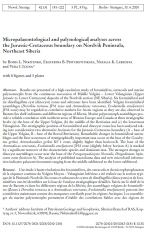Добрый день, Коллеги. Важное сообщение, просьба принять участие. Музей Ферсмана ищет помощь для реставрационных работ в помещении. Подробности по ссылке
Micropalaeontological and palynological analyses across the Jurassic-Cretaceous boundary on Nordvik Peninsula, Northeast Siberia / Микропалеонтологический и палинологический анализы на границе юрского и мелового периодов на полуострове Нордвик
Results are presented of a high-resolution study of foraminifers, ostracods and marine palynomorphs from the continuous succession of Middle Volgian – Lower Valanginian (Upper Jurassic to Lower Cretaceous) deposits of the Nordvik section (NE Siberia). Six foraminiferal and six dinoflagellate cyst (dinocyst) zones and subzones have been identified. Volgian foraminiferal assemblages (Dorothia tortuosa JF51 zone and Ammodiscus veteranus, Evolutinella emeljanzevi JF52 zone) may be regarded as correlative markers for Arctic regions as they are also observed in Barents Sea shelf sediments and different regions of Siberia. Marine palynomorph assemblages provide a reliable correlation with northern areas of Western Europe and Canada at three stratigraphic levels: (a) the base of the Upper Volgian, (b) the middle of the Berriasian and (c) the lowermost Valanginian. The stratigraphic position of foraminiferal and dinocyst zones has been analyzed taking into consideration two alternative horizons for the Jurassic-Cretaceous boundary (A – base of the Upper Volgian, B – base of the Boreal Berriasian). Remarkable changes in foraminiferal assemblages and the first occurences of stratigraphically important taxa occur at the base of the Gaudryina gerkei, Ammobaculites gerkei KF 1 zone, slightly higher than horizon B. The base of the Ammodiscus veteranus, Evolutinella emeljanzevi JF52 zone (slightly below horizon A) is marked by a significant turnover of the characteristic species and dominant taxa. The strongest changes in dinocyst assemblages occur near the base of the Paragonyaulacysta ?borealis, Dingodinium ?spinosum zone (horizon A). The analysis of published macrofauna data and new microfossil information indicates palaeoenvironments ranging from the middle sublittoral to the lower sublittoral.




